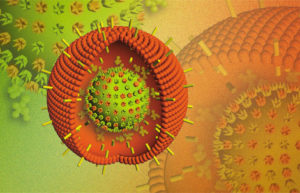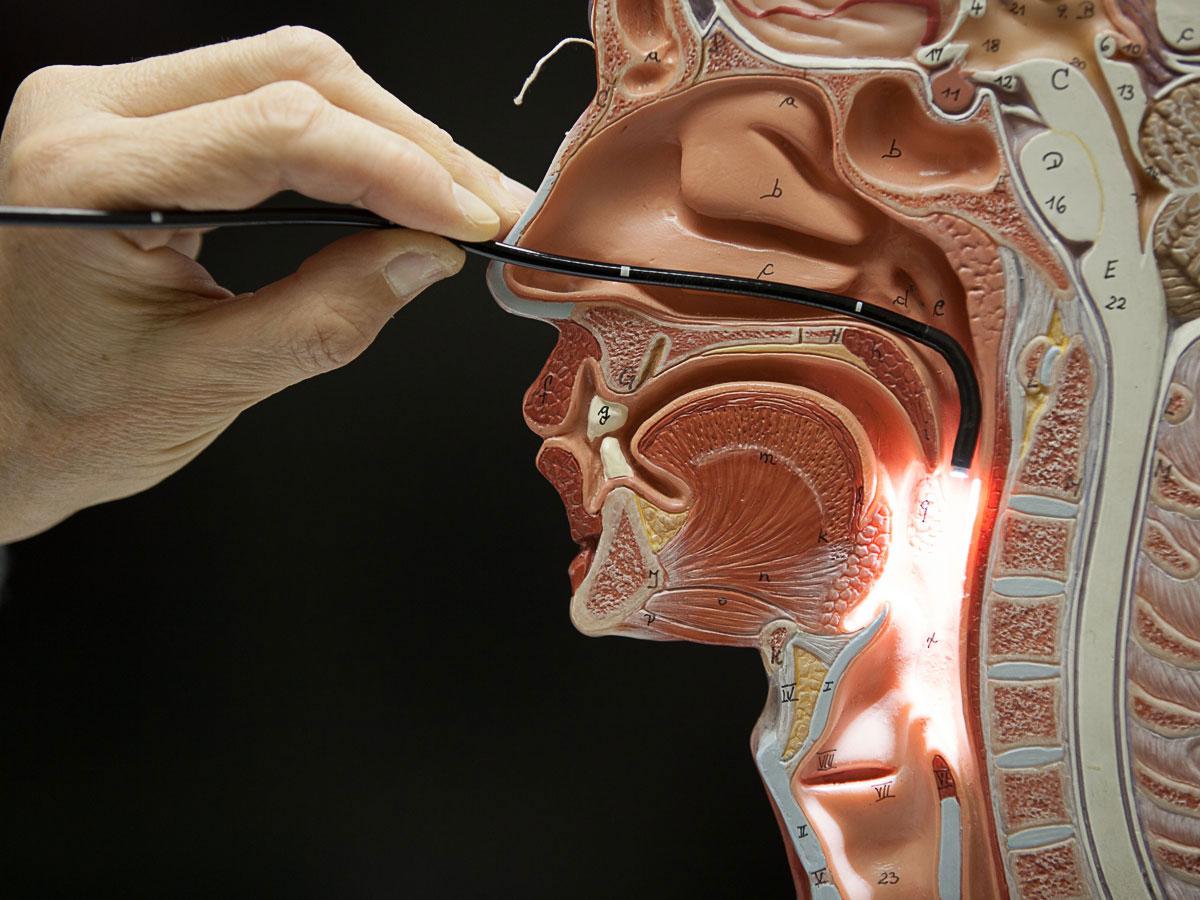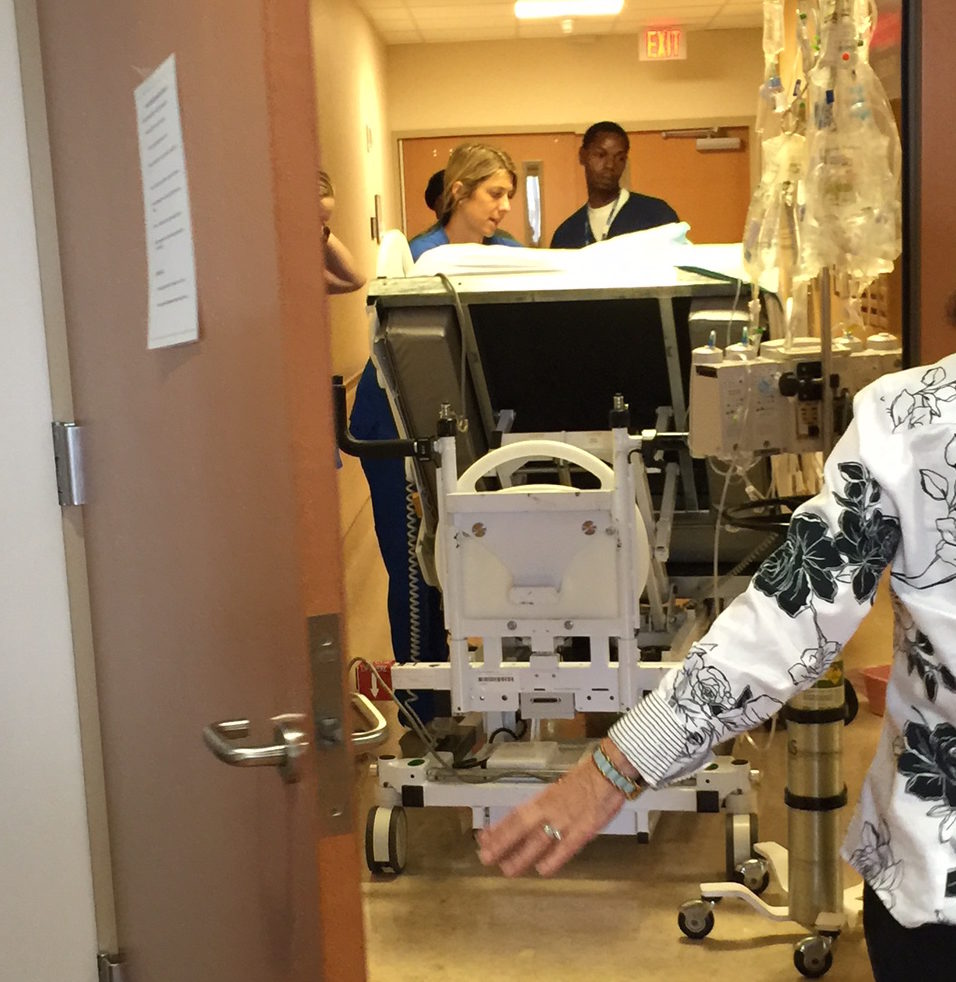by Jena | Apr 25, 2016 | BK virus, Cytomegalovirus (CMV), Epstein-Barr virus (EBV), Sirolimus, Stem Cell Transplant |
Day +22, Sunday, April 24, 2016
WBC: 2.86 k/uL LOW H: 9.7 g/dL LOW P: 11 k/uL LOW BUN: 83 HIGH Cr: 4.7 CRITICAL Na+: 143 NORMAL
Mentation. Dr. Ochoa-Bayon, inservice BMT, found Dad to be somnolent, but rousable. At times, Dad mumbled and was able to follow some simple commands. Dr. Baluch, BMT infectious disease, found Dad to be less anxious than the day before.

Epstein-Barr Virus, also called the Human Herpesvirus 4, is commonly known as “mono.”
Blood. Dad had a low grade fever during the night. Planned to repeat test for Epstein-Barr Virus (EBV; Human Herpesvirus 4 (HHV-4)) and Cytomegalovirus (CMV; Human Herpesvirus 5 (HHV-5)) on Monday. Set target to keep platelets above 50
A constant challenge is to keep the nurses and technicians, who change every 12 hours, keenly aware of Dad’s thin skin. He has such thin skin as a result of his cancer (CTCL). Nearly all of the medical staff under appreciate how thin Dad’s skin is. They incorrectly assume Mom and I are warning them just because we don’t want a slight tug on his skin. Nearly all types of adhesion (even paper tape) peels Dad’s skin right off. Dad is often left with an open wound when adhesive remover is not used to slowly and methodically to remove medical tape and adhesives. For immunocompromised patients, open wounds pose significant risk for infection.
Dr. Baluch monitored such open wounds on Dad’s chest (adhesive improperly removed during the procedure to remove Dad’s central line catheter last week). She checked on a second open wound on his right, lower back.
No results returned yet from the HHV-6 test conducted the day before.
Lungs. The chest X-Ray, taken the day before, showed an abnormal amount of fluid around Dad’s right lung (pleural effusion) with intermittent collapse or closure of a portion of the lung. Dad continued to be supplemented with oxygen via mask at 3L.
Abdomen. The day before, Dr. Ochoa-Bayona requested an X-ray to confirm the placement of Dad’s feeding tube since Dad had been confused and pulling on his feeding tube. That X-ray prompted the need to further advance the feeding tube. A second X-ray confirmed that it was in the proper place. Dad restarted trickle feeds via his feeding tube. He was monitored for diarrhea. Discontinued D5 water IV and continued free water flushes.
Kidneys. Creatine decreased from 4.9 to 4.7. Dad had good urine output. Dad’s urine remained slightly bloody due to the BK virus. This prompted Dr. Ochoa-Bayona, inservice BMT, to reduce the amount of sirolimus (immunosuppressant) Dad received.
by Jena | Apr 24, 2016 | BK virus, Dialysis, Infectious Disease, Stem Cell Transplant |
Day +19, Thursday, April 21, 2016
WBC: 1.43 k/uL LOW H: 8.5 g/dL LOW P: 18 k/uL LOW BUN: 83 HIGH Cr: 4.3 CRITICAL Na+: 150 HIGH
Mentation. Dad was alert when Dr. Ochoa-Bayona, inservice BMT, visited. He oriented to person, place, and time, but he closed his eyes during conversations. Dad was mildly confused when Dr. Baluch, BMT infectious disease, visited.
Blood. Repeated testing for BK virus. Got D5 water IV.
Mouth and Throat. Dad requested ice chips, but was still not permitted due to aspiration risk.
Lungs. Dad continued to breathe on his own. He continued to cough and have thick secretions from the mucositis.
Abdomen. Diarrhea continued. Dad’s feeding was still suspended due to the diarrhea.
Kidneys. Urine output improved again. Saw a slight increase in creatine (Cr). Monitored sodium (Na+). Urine culture conducted.
Day +20, Friday, April 22, 2016
WBC: 2.34 k/uL LOW H: 8.2 g/dL LOW P: 14 k/uL LOW BUN: 85 HIGH Cr: 4.8 CRITICAL Na+: 148 HIGH
Mentation. When Dr. Ochoa-Bayona, inservice BMT, visited in the morning, he found Dad to be more confused than the previous day. Dad could only orient to a person. Dad didn’t know where he was nor the date. He was slurring his speech. Dad remained in a confused state when Dr. Chemaly, nephrology, visited midday. Dad would only repeat back what Dr. Chemaly said. When Dr. Baluch, BMT infectious disease, came by in the evening, she felt that Dad had worsened confusion.
An EEG was performed, which tested Dad’s cerebral function. The result was abnormal and initially suggested nonspecific moderate to severe brain malfunction. No seizure activity was observed during the study. Dad’s case was reevaluated and noted that Dad had experienced acute renal (kidney) failure, BUN level was high at 85, and creatine (Cr) was trending down.
A CT scan of Dad’s brain indicated no acute cerebral lesions but did show that Dad’s sinuses were irritated and inflamed.
An MRI of Dad’s brain showed no acute changes. The MRI ruled out stroke and abscess.
Dad’s mental state to be pursued as caused by infection, toxins or metabolic problems. Dr. Chemaly believed that Dad’s mental state was unlikely due to uremia, a condition involving abnormally high levels of waste products in Dad’s blood.
Dr. Ochoa-Bayona withheld narcotics and sedatives.
Blood. Increased D5 water IV.
 Mouth and Throat. Based upon the result of the CT scan of Dad’s brain, ENT (ear, nose & throat) was consulted to check for fungal sinusitis. ENT performed a bedside Flexible Nasal Endoscopy, which showed no evidence of a fungal infection. It did show a clear, runny nose. ENT recommended continued IV antibiotics for viral and bacterial sinusitis.
Mouth and Throat. Based upon the result of the CT scan of Dad’s brain, ENT (ear, nose & throat) was consulted to check for fungal sinusitis. ENT performed a bedside Flexible Nasal Endoscopy, which showed no evidence of a fungal infection. It did show a clear, runny nose. ENT recommended continued IV antibiotics for viral and bacterial sinusitis.
Lungs. Dad was placed back on supplemental oxygen at 2L. He continued to cough and have thick secretions from the mucositis.
Abdomen. Dad’s feeding was still suspended.
Kidney. Dad’s urine output continued to improve and no longer contained blood. Dr. Chemaly, nephrology, wanted to avoid dialysis given the possibility of an ischemic stroke, which occurs as a result of an obstruction within a blood vessel supplying blood to the brain.
by Jena | Apr 17, 2016 | Atrial Fibrillation, BK virus, Dialysis, Graft-versus-host-disease (GvHD), Infectious Disease, Meropenem, Minocycline, MRSA, Sepsis, Sirolimus, Stem Cell Transplant, Zosyn |
 Dad was moved to the ICU on the second floor.
Dad was moved to the ICU on the second floor.
Day +13, Friday, April 15th.
WBC: 0.08 k/uL CRITICAL H: 7.4 g/dL LOW P: 18 k/uL LOW Cr: 3.9 HIGH Na+: 148 HIGH
Blood. All three lines (blue, red & white) in Dad’s central line catheter indicated Gram-negative bacteria. Continued minocycline for MRSA and atypical Gram-negative bacteria.
Dad continued to receive blood support (platelet and blood transfusions & neupogen shots) as needed.
Graft versus host disease (GvHD). Dad was unable to take sirolimus since he was restricted from all food and drink.
Mouth & Throat. Dad continued to have pain from mucositis and used magic mouthwash to treat.
Heart. The day before’s echo cardiogram confirmed no heart failure.
Lungs. Dad continued his liquid diet. Again, anytime he drank, he would go into a terrible coughing fit and would require use of an oral suction/vacuum. It was determined that Dad’s epiglottis was not closing properly to prevent food and drink from entering his larynx down to his lungs. The day before’s two chest X-rays showed developing aspiration pneumonia.
Dad had another X-ray taken of his chest. Continued supplemental oxygen. Ordered a nasal feeding tube, but the nurse, who specializes in feeding tube insertions, was unsuccessful in placing Dad’s tube after several attempts.
Abdomen. The day before’s abdomen X-ray showed mild improvement. Imodium was stopped. Dad was switched from Zosyn to meropenem, an ultra-broad spectrum antibiotic.
Kidneys. Nephrology discussed with us the possibility of Dad needing dialysis. The day before’s renal ultrasound showed swelling of Dad’s right kidney due to a possible obstruction. Repeated ultrasound. BK virus was finally confirmed as the source of blood in Dad’s urine. Continued IV fluids and monitored sodium levels. Nephrology also monitored potassium in Dad’s blood and identified Dad as having hypokalemia (deficiency of potassium in the bloodstream). Dad was considered anuric (not passing urine).
Legs. An ultrasound of Dad’s legs, taken the night before, confirmed no blood clots.
by Jena | Apr 17, 2016 | Atrial Fibrillation, BK virus, Epstein-Barr virus (EBV), Folotyn, Ileus, Infectious Disease, Lasix, MRSA, Rituximab, Stem Cell Transplant, Vancomycin, Zosyn |
Catching you up from last Saturday to Wednesday…
Day +7, Saturday, April 9th.
WBC: 0.03 k/uL CRITICAL H: 7.3 g/dL LOW P: 16 k/uL LOW
Dad had continued to go in and out of atrial fibrillation. By the evening, his heart was in normal sinus rhythm (NSR). Dad felt that his abdomen had improved.
Dad noticed increasing throat pain with swallowing. Oral mucositis (mouth sores) can be extremely painful and can result in an inability to eat, speak, or swallow. Last summer, when Dad had received Folotyn (pralatrexate) chemotherapy, he had suffered from oral mucositis. Dad had used magic mouthwash to get some relief. Magic mouthwash is the term given to a solution used to treat oral mucositis.
Abdominal fluid retention improved slightly. Dad had an abdominal X-ray taken.
His diarrhea remained improved. He remained fever free. He remained on 2 L/min oxygen.
MRSA was confirmed on April 6th once Staphylococcus was identified on April 5th.
Day +8, Sunday, April 10th.
WBC: 0.01 k/uL CRITICAL H: 7.3 g/dL LOW P: 13 k/uL LOW
Report from the day before’s abdominal X-ray showed mildly prominent loops in his small intestine, which possibly represented ileus or enteritis. Ileus is the inability of the intestine to contract normally and move waste out of the body. Enteritis is inflammation of the intestine usually accompanied with diarrhea. Dad’s diet was downgraded to clear liquids. His abdominal swelling was improved, yet he continued to receive lasix, a diuretic, to address the fluid retention.
Dad had an X-ray of his chest taken. He was breathing on his own.
Dad switched to an oral amiodarone to manage his atrial fibrillation.
He continued to be monitored for EBV (Epstein-Barr virus), which is more commonly known as mononucleosis or “mono.” Most people will be infected with EBV in their lifetime and will not have any symptoms since it is controlled by a healthy immune system. Yet, when someone has a weakened immune system, the EBV infection can get out of control.
Day +9, Monday, April 11th.
WBC: 0.04 k/uL CRITICAL H: 8.2 g/dL LOW P: 5 k/uL CRIT
The prior day’s chest X-ray suggested inflammation in Dad’s lungs versus fluid overload. Dad’s respiratory culture showed both “gram-positive” and “gram-negative.” These are terms used to classify bacteria into two groups. Usually, gram-positive bacteria are helpful, and gram-negative are the ones that cause illness.
Dad’s atrial fibrillation continued to be addressed with the oral amiodarone. He continued to receive lasix, a diuretic, to address the fluid retention. Dad remained on a clear liquid diet.
The blood in Dad’s urine was suspected to be the BK virus and adenovirus. For most, the BK virus has no consequences since it remains latent, but it can be reactivated during post stem cell transplant when immunosuppressed.
Dad was too tired to work with physical therapy.
Day +10, Tuesday, April 12th.
WBC: 0.02 k/uL CRITICAL H: 8.2 g/dL LOW P: 7 k/uL CRIT
Dad started to choke/cough when eating ice or drinking liquids. Yet, Dad said that his cough had improved and was no longer producing sputum, which is a mixture of saliva and mucus. Respiratory culture from the day before likely indicated MRSA.
Dad’s sodium was high at 148 mmol/L..
Day +11, Wednesday, April 13th.
WBC: 0.01 k/uL CRITICAL H: 8.0 g/dL LOW P: 12 k/uL LOW
Dad continued to be monitored for EBV. Based upon the latest EBV test results, Dr. Ayala, Dad’s primary BMT doctor, was consulted. It was determined that Dad would receive an infusion of rituximab. Rituximab is used to treat EBV post stem cell transplant. Since Dad experienced rigors, fatigue and mild confusion in the morning, the rituximab treatment was postponed.
Dad complained of further pain in his mouth and throat. Dad continued to take oxycodone and magic mouthwash to provide relief from the mucositis. Two X-rays were taken (chest and abdomen). Dad restarted supplemental oxygen.
His cultures indicated MRSA. Dad was started on two new antibiotics, vancomycin and Zosyn (piperacillin/tazobactam). Vancomycin is used to treat infection of the intestines. Zosyn is the combination of two penicillins.
Dad experienced an abnormal heart rate last night, which was resolved with metoprolol. Dad’s atrial fibrillation continued to be addressed with the oral amiodarone. He continued to receive lasix, a diuretic, to address the fluid retention. Dad remained on a clear liquid diet. Dad had a foley catheter placed since he was at a high fall risk. Dad was given Imodium to treat his diarrhea.
Adenovirus was ruled out as the cause of blood in Dad’s urine. BK virus was still a possibility. Set a goal to maintain Dad’s platelets at 20.
Dad’s sodium was high again at 147 mmol/L. Dr. Baluch, BMT infectious disease, noted that Dad’s T. bilirubin was mildly elevated and wanted to monitor trend.


 Mouth and Throat. Based upon the result of the CT scan of Dad’s brain, ENT (ear, nose & throat) was consulted to check for fungal sinusitis. ENT performed a bedside Flexible Nasal Endoscopy, which showed no evidence of a fungal infection. It did show a clear, runny nose. ENT recommended continued IV antibiotics for viral and bacterial sinusitis.
Mouth and Throat. Based upon the result of the CT scan of Dad’s brain, ENT (ear, nose & throat) was consulted to check for fungal sinusitis. ENT performed a bedside Flexible Nasal Endoscopy, which showed no evidence of a fungal infection. It did show a clear, runny nose. ENT recommended continued IV antibiotics for viral and bacterial sinusitis. Dad was moved to the ICU on the second floor.
Dad was moved to the ICU on the second floor.
Recent Comments